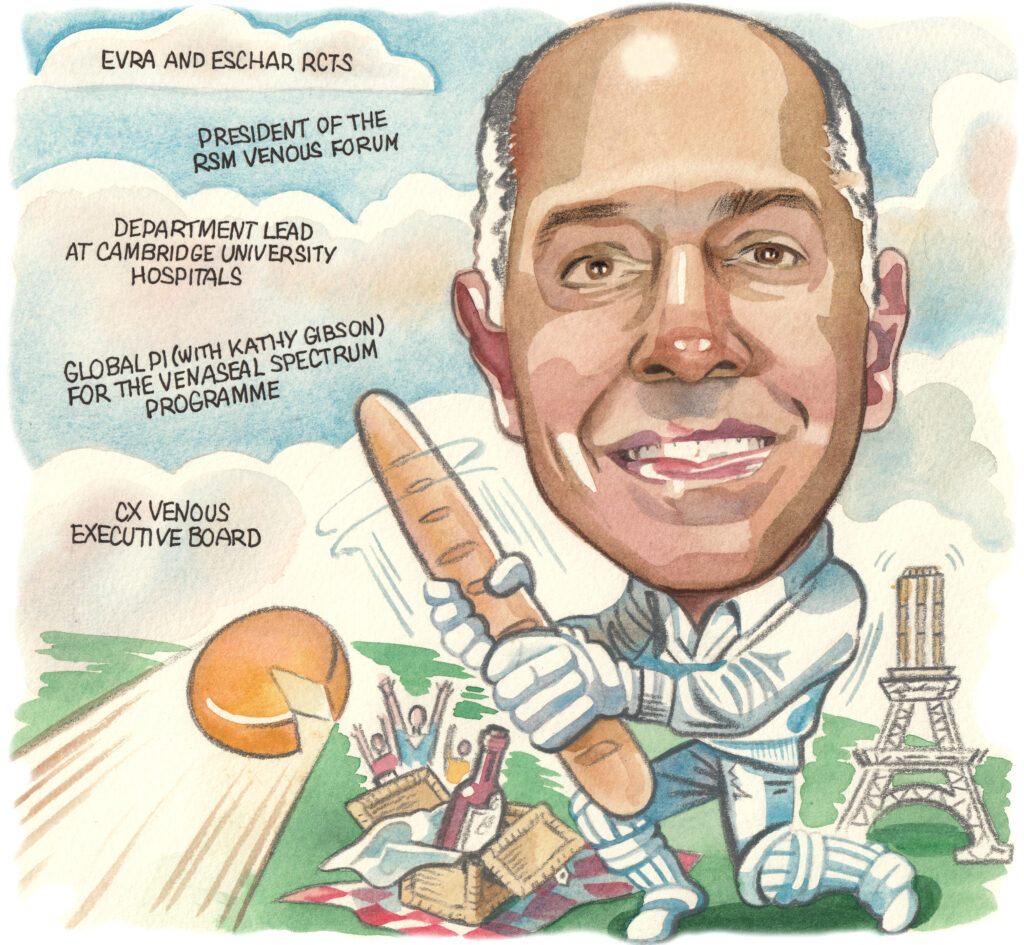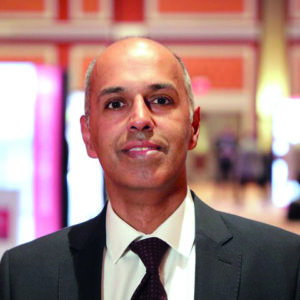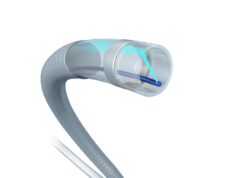 “As I learned more about venous pathologies, it became abundantly clear that patients with venous disease were a largely neglected population in need of strong, passionate advocates,” Manj Gohel (Cambridge and London, UK) tells Venous News, recalling his decision to specialize in the treatment of venous disease. Gohel is now at the forefront of venous care—a consultant vascular and endovascular surgeon at Cambridge University Hospitals NHS Foundation Trust, clinical lead for the Cambridge Vascular Unit and honorary senior lecturer at Imperial College London. He shares in this interview some career highlights so far, as well as his thoughts on the venous space more widely, outlining some key challenges that must be addressed—notably case selection and the ongoing debate regarding appropriate care—while also stressing that the venous field is currently a “vibrant space” for ongoing clinical research.
“As I learned more about venous pathologies, it became abundantly clear that patients with venous disease were a largely neglected population in need of strong, passionate advocates,” Manj Gohel (Cambridge and London, UK) tells Venous News, recalling his decision to specialize in the treatment of venous disease. Gohel is now at the forefront of venous care—a consultant vascular and endovascular surgeon at Cambridge University Hospitals NHS Foundation Trust, clinical lead for the Cambridge Vascular Unit and honorary senior lecturer at Imperial College London. He shares in this interview some career highlights so far, as well as his thoughts on the venous space more widely, outlining some key challenges that must be addressed—notably case selection and the ongoing debate regarding appropriate care—while also stressing that the venous field is currently a “vibrant space” for ongoing clinical research.
Why did you decide to pursue a career in medicine and to specialize in vascular and venous surgery?
I grew up in Birmingham, UK, and my plan at school was always to study mathematics at university. I only considered medicine after speaking to a doctor at a careers event and his infectious passion and enthusiasm really stood out for me. Despite the enormous challenges of working in healthcare, particularly the UK National Health Service (NHS), I have never regretted my decision. It is an enormous privilege to work in healthcare and to be trusted by patients and families during their most difficult times.
During my junior surgical training, I thoroughly enjoyed all the different specialities I worked in. However, I was particularly fascinated by vascular surgery, as blood vessels had been a source of great fear and anxiety previously. Much of my vascular training occurred during the endovascular revolution, adding an exciting new dimension of therapies to traditional open surgery. Vascular surgery offers technically challenging surgeries and dramatic acute clinical presentations, but is also enormously unforgiving and undoubtedly tests your resilience. My interest in venous disease stems from my involvement in the ESCHAR trial, early in my surgical career. As I learned more about venous pathologies, it became abundantly clear that patients with venous disease were a largely neglected population in need of strong, passionate advocates.
Who have been your career mentors and what is the best advice they have given?
I have been enormously fortunate to have worked with some inspirational trainers and mentors, many of whom are now close friends. As an eager, but unfocused junior surgeon, I worked with Keith Poskitt, a vascular surgeon in Cheltenham (a district hospital in the UK). He had set up an outstanding, nurse-led leg ulcer service in the region, and despite limited resources, he had inspired the ESCHAR study. Keith was inspirational for his single-minded passion, always putting the patient first. I was able to join the research team and have been heavily involved in venous/leg ulcer research ever since.
After moving to London to continue my training, I worked with Alun Davies and we continue to work closely on several research projects. I have learned many things from Alun, not least the importance of collaboration and the power of being inclusive. The EVRA study is a tremendous example of how a strong collaboration between passionate researchers can result in successful and impactful clinical research.
Since completing vascular surgery training, I have worked in Cambridge University Hospitals with outstanding and supportive colleagues and been fortunate to hold national and international roles which have allowed me to work with several pioneers and leaders as well as younger rising stars. The common theme is that success relies not on individuals, but on teams of motivated, talented people working together towards a common goal. The best advice I received was to “always listen to the patient”. Simple advice, but easy to forget in the temptation to perform endless scans and treat images.
It continues to be an honor to work with my venous colleagues as part of the Charing Cross (CX) Executive team (with Stephen Black and Erin Murphy).
What has been the most important development in the venous space over the course of your career so far?
After a century of stagnation, there have been major advances in venous diagnosis and treatment over the last 20 years. Recent advances in deep venous interventions such as stents and thrombectomy are exciting, but it is important to remember that most of the venous disease diagnosed and treated worldwide is superficial reflux. For this reason, the development of endovenous modalities to treat superficial reflux has had an enormous impact and massively increased accessibility of superficial venous procedures for patients with venous disease. This is particularly the case for the frail population with C5 and C6 disease, who can virtually all be treated with endovenous ablation procedures.

What are the biggest challenges currently facing the venous world?
In many ways, the venous space has never been better in terms of innovation, technology, and research. For the first time, we have the interventions capable of treating the complex array of deep and superficial venous pathologies we encounter. However, case selection remains an enormous challenge. This is illustrated by the ongoing debate regarding early thrombus removal for acute iliofemoral deep vein thrombosis (DVT), where the published randomized controlled trials (RCTs) have been underwhelming in showing benefit for early thrombus removal. Virtually all venous specialists acknowledge that some patients derive enormous clinical benefit from early thrombus removal, but we struggle to define who. The same applies to pelvic vein embolization, deep venous stenting and perforator ablation procedures. Perhaps research efforts should focus on which patients to treat, rather than which stent/catheter/ thrombectomy device/catheter to use.
The explosion of new devices to treat venous disease does present a challenge as device introduction is often driven by commercial, rather than clinical motivations. The ongoing debate regarding appropriate care and avoidance of overtreatment is as strong as ever. Unfortunately, the greatest driver of venous treatment strategy is reimbursement, rather than evidence-based best care.
Perhaps the biggest challenge relates to a lack of workforce in many countries (including the UK) to assess and treat venous disease. Traditional models of care need to be challenged, as there is an enormous unmet need, particularly with the management of venous leg ulceration, post-thrombotic syndrome and pelvic venous disease.
Could you outline some of the trials you are currently involved in?
The venous field is a vibrant space for ongoing clinical research, and I am fortunate to be involved in several exciting projects at present. The THRIVE study is a multicenter UK RCT aiming to establish whether thromboprophylaxis reduces the risk of venous thromboembolism (VTE) post endovenous ablation procedures. A new venous ulcer platform model has been developed in the UK, which will hopefully allow leg ulcer clinical trials to be performed easily and without extensive infrastructure difficulties. In Cambridge, we are looking at artificial intelligence technologies to improve diagnosis and predict outcomes after venous treatments—watch this space!
Along with Kathy Gibson, I am global principal investigator for the VenaSeal Spectrum program, which consists of three distinct studies to evaluate the role of VenaSeal (Medtronic) closure in modern endovenous practice. Two of the studies are randomized clinical trials comparing VenaSeal to surgical stripping and endovenous thermal ablation. We are excited to share the results in podium-first presentations at CX 2024. While no clinical trial is perfect, randomized clinical trials form the foundation of daily clinical practice.
What do you think are some of the major trials needed in the venous space?
I think the recent development of multiple thrombectomy devices for iliofemoral DVT is enormously significant as the avoidance of lytic infusion should make early thrombus removal procedures much safer. While I recognize the inconclusive results from ATTRACT, CAVA and CaVenT trials, there needs to be a robust, prospective evaluation of thrombectomy versus anticoagulation alone. RCTs are planned in this field, but given the enormous criticism of previous trials (mainly due to selection bias/lack of equipoise), I wonder if more innovative study designs (such as observational studies with embedded RCTs) may be a more elegant and productive way to answer the question.
We are also in desperate need of large, prospective deep venous stenting trials, to provide robust evidence to support these increasingly popular interventions. Hopefully, C-TRACT will help move the needle, but I fear that this trial will be besieged by many of the same challenges that befell ATTRACT.
What will you take away from your role as president of the Royal Society of Medicine (RSM) Venous Forum?
I have had the honor of being the president of the RSM Venous Forum since late 2021 and the role has involved educational and political activities. I have realized that provision of venous care is nowhere near where we would like it to be in the UK, or internationally.
COVID-19 has had a big, negative impact, but it is frustrating that we are having the same arguments with payors and policy makers as 20 years ago. However, through multidisciplinary education and events, we can continue to create enthusiastic teams of skilled professionals who can become the next generation of activists and educators.
Could you outline one of your most memorable cases?
I vividly recall the case of a young male patient who had suffered with a venous ulcer for more than 20 years. He had readily treatable venous obstruction and superficial reflux and after uncomplicated deep vein stenting and great saphenous vein (GSV) ablation, his ulcer healed within two months. He was memorable because the ulcer had an enormous impact on his life. He had confidence and mental health issues, which resulted in the breakdown of his marriage. He lost his job. The venous interventions and ulcer healing was the catalyst to change his outlook on life for the better. This case is an important reminder of how severely venous disease/ulceration can impact patient quality of life.
What advice would you give to someone looking to start a career in medicine?
A career in medicine is undoubtedly hard work and requires enormous motivation. The last few years have been very tough for healthcare professionals, particularly those working in state health systems. However, being a doctor is an enormous privilege and I am reminded regularly how we can transform people’s lives for the better. A career in medicine is incredibly varied and very sociable, with the opportunity to work around the world. If you want to make a difference, then medicine is a fantastic career choice. Venous disease has seen a massive increase in interest in recent years. While there is still a long way to go, we now have exciting diagnostics, interventions and research opportunities, making it an excellent specialty choice. There is an enormous unmet need and a growing group of passionate and like-minded venous specialists who are inspiring the next generations.
What are your hobbies and interests outside of medicine?
Outside work, I try to spend as much time with my family as possible. My wife Tanya continues to demonstrate superhuman levels of tolerance, and my daughters Olivia and Clara are a constant source of joy and teenage drama. Family holidays are spent almost exclusively in France, where we all feel at home. We enjoy skiing, sport in general including cricket, and traveling.









